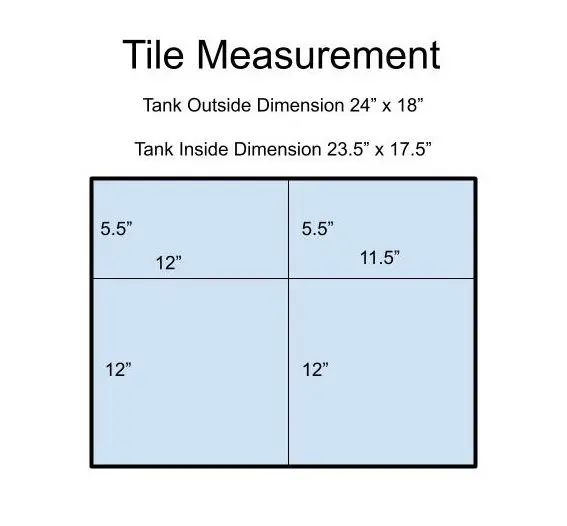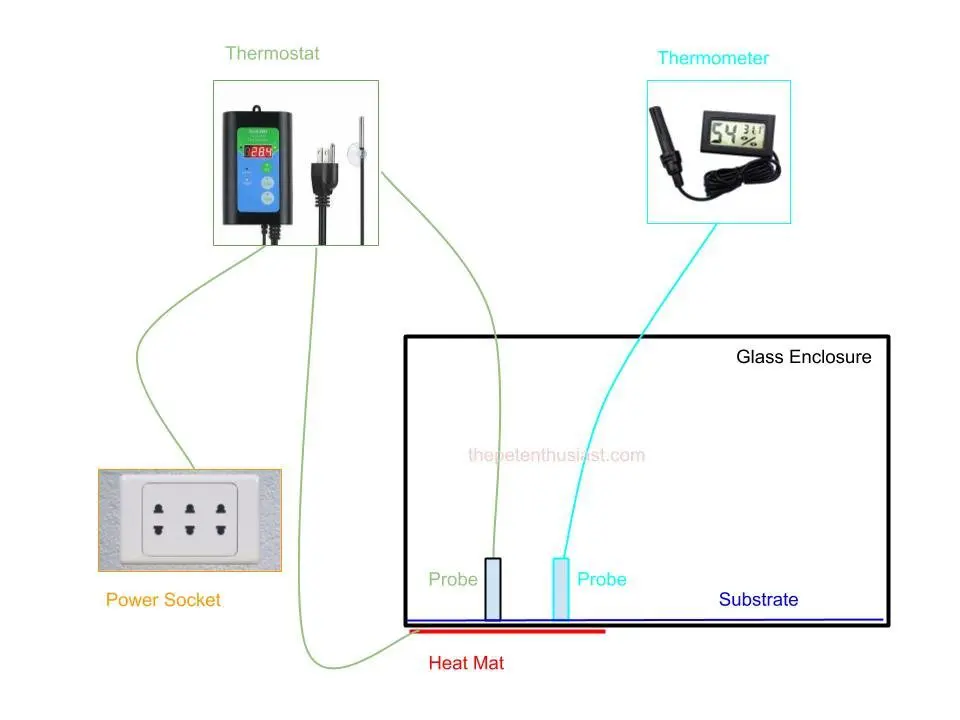Choosing a substrate for your leopard gecko tank is a big decision. You want it to look natural, be easy to clean, and be affordable in price.
Maybe you’re wondering if you should use tile in your leopard gecko tank or you’re wondering what type of tile to use. Maybe you are concerned about any downsides tile may have in the enclosure setup.
Continue reading to find out what you need to know about using tile in your reptile enclosure.
Pros of Using Tiles in a Leopard Gecko Enclosure
Affordable
One of the many reasons that tiles remain a leading substrate choice for many leopard gecko owners is the affordable pricing. You can buy tiles cheap, making them a cost effective substrate choice.
Easy to Clean
If you think about the tiles in your home and how easy they are to clean, you can enjoy the same benefit when you add tile as a substrate for your leopard gecko.
Tiles can be easily wiped clean for spot cleans or wiped with disinfectant for full cleans with ease. Tile can save you time and energy when it comes to your tank maintenance
Retains Heat
Some tiles, especially ceramic and slate tiles are able to retain heat, dispersing it well.
This is great in a leopard gecko enclosure, where you are already using a heat mat for under tank heat. Tile can help you maintain the right temperature for your pet.
Natural Look
Tile not only provides a clean and affordable substrate solution, but it can also look completely natural in the enclosure. This helps you create the perfect habitat to ensure the comfort and safety of your pet.
Doesn’t Hold Odors
One of the biggest problem gecko owners struggle with is eliminating any unwelcome odors. Tile isn’t porous; therefore, it doesn’t absorb odors, leaving you with a clean smelling habitat.
Safe
Tile is safe for your leopard gecko. There is no risk of impaction or getting their claws stuck. You can put in the tile with complete peace of mind knowing your pets will be safe with tile as the substrate of choice.
Long Lasting
All the reptile substrates you purchase will need to be replaced from time to time.
Paper towel needs replacing regularly, coconut fibers and eco earth need to be changed every few months, but the good news is that tiles are long lasting.
They should not chip or get damaged as long as you handle them with care. Tiles offer a good return on investment when used as a leopard gecko substrate.
Cons of Using Tiles in a Leopard Gecko Enclosure
Cutting to Size
It can be very difficult to cut the tiles to the exact size you need. It’s recommended to get the store or a professional to do the cutting for you. Tiles can crack and break when cutting.
Heavy
Tiles are heavier than the other substrates, which means that you need to take great care when placing and removing the tile from the enclosure, especially in a glass enclosure that can also crack easily.
Best Types of Tile Used in Leopard Gecko Tanks?
There are three common tiles used by leopard gecko owners as substrate in their enclosures, these include:
- Slate tiles
- Ceramic tiles
- Porcelain tiles
Slate Tile
Slate tiles are the most popular tile choice amongst leopard gecko owners. Slate tile is excellent at retaining heat and is very easy to clean while being completely safe for your reptile pet.
The downside is that slate tile is very heavy and very difficult to cut to the right size.
Ceramic Tile
Ceramic tiles are also a top choice for substrate in a leopard gecko enclosure. Ceramic tiles eliminate the risk of impaction, they look beautiful and natural and they are so easy to clean.
The downside is that ceramic tiles can be difficult to install initially.
Porcelain Tile
Porcelain tiles are cheap and easy to clean. They come in a variety of colors and eliminate the risk of impaction.
You will find it very difficult to cut these tiles to size and initial installation can be tricky.
Tile Thickness
The best tile thickness for a leopard gecko enclosure should be 1/4″.
Smooth or Textured?
Leopard geckos do not have sticky feet that enable them to clamber around the sides of the tank, which also means that they don’t have grip on the tile, which is why textured tiles are recommended.
Textured tiles can help your reptile feel confident when moving around the enclosure and can assist with wearing down their claws.
Adhesive or Non-Adhesive Tiles
Remember when selecting your tile, you will have an under tank heater in place below the tile. Therefore, you don’t want adhesive tiles, definitely choose non-adhesive. Adhesive tiles can release dangerous fumes when they get hot.
Non-adhesive is quick and easy to remove and replace for cleaning and maintenance.
Tile Size
The first step is to work out how much tiling you need to cover the bottom of the enclosure with a natural looking, easy to clean, and odorless tile.
When you buy tiles, such as 12” x 12” tiles, they are never really the exact size, which is where it becomes tricky.
This means you need to purchase more tiles to cover the area, some will be left uncut and others will be cut into wide sections.
It’s recommended you ask your hardware store to cut the tiles for you.

Take this leopard gecko tank 24″ x 18″ x 12″ as an example. After careful measuring, the inside floor dimension is 23.5″ x 17.5″. For this layout, you will need 3 tiles in total:
- 1 tile will remain whole
- 1 tile will cut to 12″ x 11.5″
- 1 tile will be cut into 2 pieces. One piece with 12″ x 5.5″ and one piece with 11.5″ x 5.5″
Where to Get Tiles
You can buy tiles in most hardware and home stores, including Lowe’s and Home Depot. The Tile Shop and The Builder Depot are also top choices in the USA for tiles.
Some of the Home Depot’s and Lowe’s will cut the tiles to your custom size for free, which reduces the risk of you damaging the tiles when setting up your enclosure.
You can also purchase quality tiles on Amazon, but these you will need to cut to size yourself. There are a variety of sizes you can choose to fit your leopard gecko tank.
In the event, you cannot find the right size tiles or you cannot get the tiles cut to size. Cover a part of the floor with the tiles and the remainder with paper towel or shelf liner. All these substrates are safe for your reptile and will not cause impaction.
Some of the best tiles for your leopard gecko enclosure are:
- Trademark Innovations Slate Drink Coasters – A set of 4″x4″ non-adhesive stale tiles. Thickness is 1/4″ which is exactly what you need for a leopard gecko enclosure.
- Silverado Gray 6X6 Marble Tumbled Mosaic Tile – A set of 6″x6″ non-adhesive mosaic tile.
- Ivory (Light) Travertine 4 X 4 Field Tile – 4″x4″ tile with 1cm thickness
Leopard Gecko Tiles Setup

Heat mat setup in a leopard gecko enclosure using tiles
Setting up tiles in a leopard gecko tank is simple:
- Disinfect tank and decide on a location
- Install heat mat under enclosure on the warm side
- Place paper towels or cotton towels on the floor of the enclosure and cover with your carefully selected tiles. The towel will reduce the risk of the tiles breaking the glass of the enclosure.
- Plug thermostat into heat mat and place probe in the enclosure for accurate temperature maintenance
- Use a digital thermometer or a heat gun to measure temperature and ensure the tiles are not retaining too much heat.
You do not seal the tiles. Leaving the tiles standing on their own makes it easier to remove and replace them when cleaning.
In the event that the tiles don’t fit and you do have a large gap between them, then you can consider a sealant.
Don’t forget to place a layer of paper or cotton towel down between the tiles and the glass of the enclosure to reduce the risk of breaking.
Using Leopard Gecko Tile with a Heat Mat
A big concern for leopard gecko owners is how to use tiles and a heat mat.
Heat mats are necessary to set up a comfortable habitat for your leopard gecko, but you want to ensure that there is enough heat getting though and that the tiles are training and dispersing the heat. Tiles are better at retaining heat than reptile carpets.
Remember to place the thermostat probe on the tile floor to measure the floor temperature. Use tape to make sure the thermostat probe is not moved by accident.
Related – Best heat mat for leopard geckos.
Cleaning and Maintenance
Cleaning and maintenance become easier once you change your substrate to tile. You should provide a daily clean, which involves removing any dirt, left over food, and poop from the enclosure. The tiles don’t hold the odor, so the enclosure will remain odor free.
Every month you want to do a thorough clean. This is when you carefully remove everything from the enclosure, including the tiles. You can wipe the tiles with a reptile disinfectant to ensure they are clean before returning them to the enclosure on top of a clean paper towel.
Most geckos tend to defecate in the same spot. Once you have had your reptile for a while, you will find their spot.
To save you having to spot clean the entire enclosure daily, you can place a paper towel in their toilet area, enabling you to simply change the paper as needed.
Conclusion
Tiles are a great choice for your leopard gecko. The ease of maintenance and cleaning alone is an advantage that cannot be ignored. They are safe, they don’t hold odors and they look stylish and natural.
Hi, thanks for the guide! I’m using an Inkbird 306T with exo terra heat cable under my tile and an extra digital thermometer. I was wondering if the probes should layflat on the tike or just tip down is fine? I’m getting a 4 degree F difference between the two probes.
Thanks 😊
I think they won’t make much difference. However, laying flat on the tile is better for measuring temperature.
Will placing a tile over the location of the under tank heater work well for snakes also? If so, how thick of a layer of paper/cotton towel is needed to help prevent cracking of the glass?
yes, it should work the same for snakes. No worries about cracking the glass. I think a normal paper towel will work for all cases
Hi there,
I was wondering if I could grout and seal the tile, Would it that effect the heat exposer from the heat mat? I don’t know if grout will block the heat coming through.